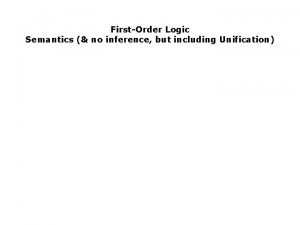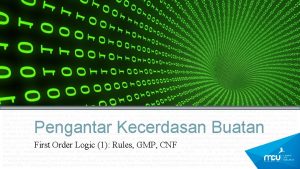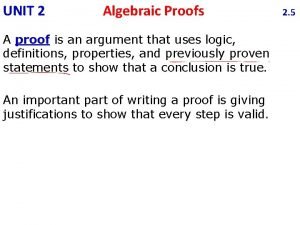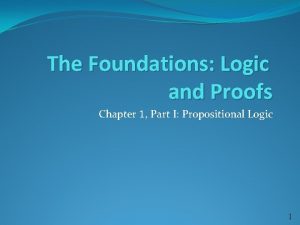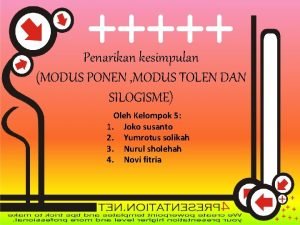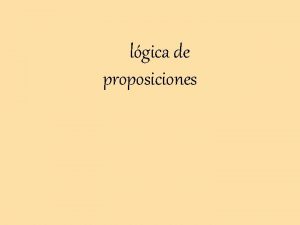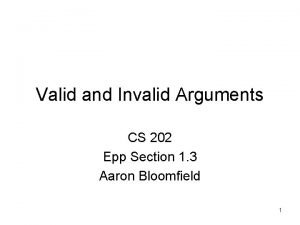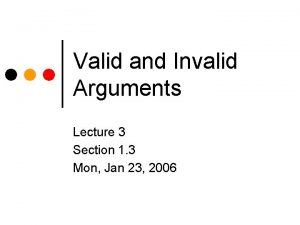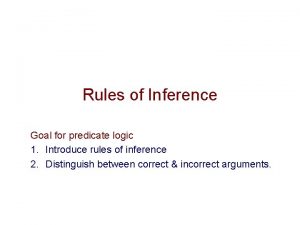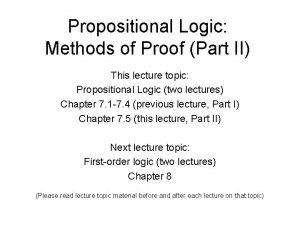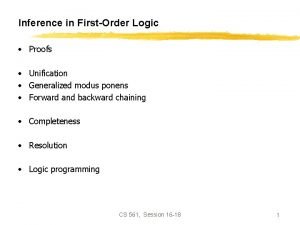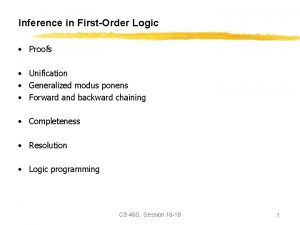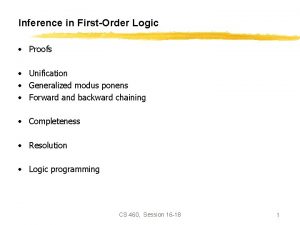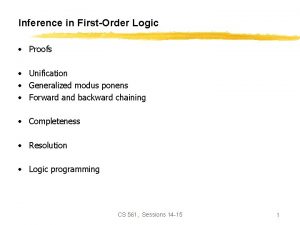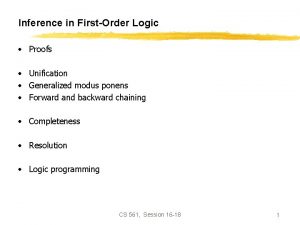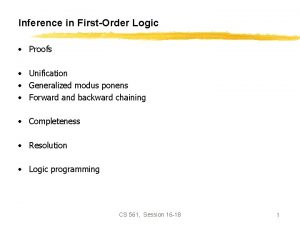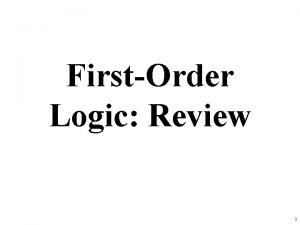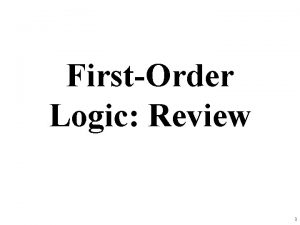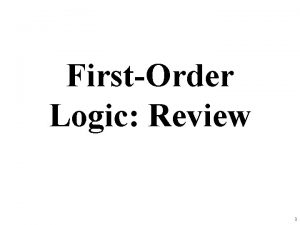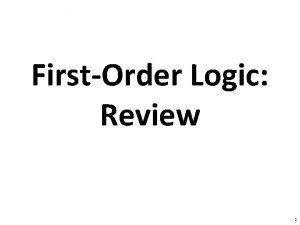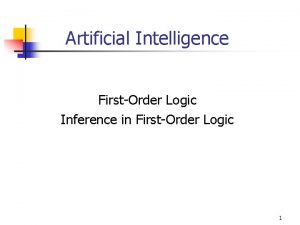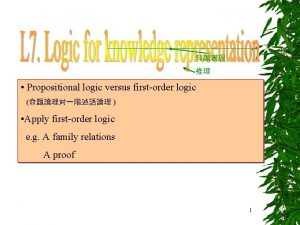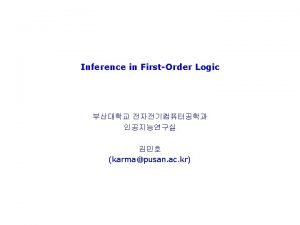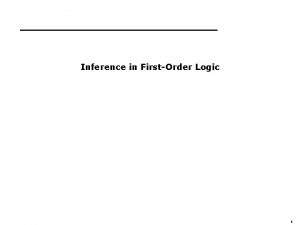Inference in FirstOrder Logic Proofs Unification Generalized modus






























- Slides: 30

Inference in First-Order Logic • Proofs • Unification • Generalized modus ponens • Forward and backward chaining • Completeness • Resolution • Logic programming 1

Inference in First-Order Logic • Proofs – extend propositional logic inference to deal with quantifiers • Unification • Generalized modus ponens • Forward and backward chaining – inference rules and reasoning program • Completeness – Gödel’s theorem: for FOL, any sentence entailed by another set of sentences can be proved from that set • Resolution – inference procedure that is complete for any set of sentences • Logic programming 2

Remember: propositional logic 3

Proofs 4

Proofs The three new inference rules for FOL (compared to propositional logic) are: • Universal Elimination (UE): for any sentence , variable x and ground term , x {x/ } • Existential Elimination (EE): for any sentence , variable x and constant symbol k not in KB, x {x/k} • Existential Introduction (EI): for any sentence , variable x not in and ground term g in , x {g/x} 5

Proofs The three new inference rules for FOL (compared to propositional logic) are: • Universal Elimination (UE): for any sentence , variable x and ground term , x e. g. , from x Likes(x, Candy) and {x/Joe} {x/ } we can infer Likes(Joe, Candy) • Existential Elimination (EE): for any sentence , variable x and constant symbol k not in KB, x e. g. , from x Kill(x, Victim) we can infer {x/k} Kill(Murderer, Victim), if Murderer new symbol • Existential Introduction (EI): for any sentence , variable x not in and ground term g in , e. g. , from Likes(Joe, Candy) we can infer x {g/x} x Likes(x, Candy) 6

Example Proof 7

Example Proof 8

Example Proof 9

Example Proof 10

Search with primitive example rules 11

Unification 12

Unification 13

Generalized Modus Ponens (GMP) 14

Soundness of GMP 15

Properties of GMP • Why is GMP and efficient inference rule? - It takes bigger steps, combining several small inferences into one - It takes sensible steps: uses eliminations that are guaranteed to help (rather than random UEs) - It uses a precompilation step which converts the KB to canonical form (Horn sentences) Remember: sentence in Horn from is a conjunction of Horn clauses (clauses with at most one positive literal), e. g. , (A B) (B C D), that is (B A) ((C D) B) 16

Horn form • We convert sentences to Horn form as they are entered into the KB • Using Existential Elimination and And Elimination • e. g. , x Owns(Nono, x) Missile(x) becomes Owns(Nono, M) Missile(M) (with M a new symbol that was not already in the KB) 17

Forward chaining 18

Forward chaining example 19

Backward chaining 20

Backward chaining example 21

Completeness in FOL 22

Historical note 23

Resolution 24

Resolution inference rule 25

Remember: normal forms “product of sums of simple variables or negated simple variables” “sum of products of simple variables or negated simple variables” 26

Conjunctive normal form 27

Skolemization 28

Resolution proof 29

Resolution proof 30
 Unknown angle proofs
Unknown angle proofs Lesson 9 unknown angle proofs
Lesson 9 unknown angle proofs Fol unification
Fol unification Knowledge engineering in first order logic
Knowledge engineering in first order logic Generalized modus ponens
Generalized modus ponens Segment addition proof
Segment addition proof Unit 2 logic and proof homework 1
Unit 2 logic and proof homework 1 The foundations logic and proofs
The foundations logic and proofs The foundations logic and proofs
The foundations logic and proofs Contoh kalimat modus ponens
Contoh kalimat modus ponens Modus tollens
Modus tollens Ponens
Ponens Modus ponens and modus tollens
Modus ponens and modus tollens Motus ponens
Motus ponens Modus tollens example
Modus tollens example Predicate logic rules of inference
Predicate logic rules of inference Using logic
Using logic What is inference in logic
What is inference in logic Tw
Tw Logic chapter three
Logic chapter three First order logic vs propositional logic
First order logic vs propositional logic Software development wbs
Software development wbs First order logic vs propositional logic
First order logic vs propositional logic Is it x y or y x
Is it x y or y x Concurrent vs sequential
Concurrent vs sequential Combinational logic sequential logic 차이
Combinational logic sequential logic 차이 First order logic vs propositional logic
First order logic vs propositional logic C section
C section Prolog unification
Prolog unification Chapter 23 lesson 3 nationalism unification and reform
Chapter 23 lesson 3 nationalism unification and reform Strong devotion
Strong devotion


